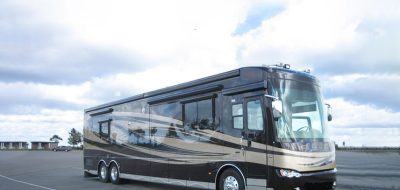As an RVer, you can come across many different water sources in your travels. Most campgrounds and RV parks take care to ensure their water supply is free of contaminants by pre-filtering the water before it arrives at your RV. Often though, the water doesn’t taste very good either because it was improperly filtered or not filtered at all. Or maybe the chlorine levels are so high to prevent bacterial growth that you think you’re drinking pool water. There are several drinking water filter solutions you can easily modify your RV with to get the best tasting water possible. So here is the low-down on various types of filtration systems available.
1. The simple carbon water filter
This is the most common type of filter used to improve water taste and filter out contaminants such as Cryptosporidium and Giardia. These nasty microscopic parasites can wreak havoc on your intestinal tract. The carbon filter is pretty good at trapping these little critters but still allows minerals to pass through, providing good taste without the worry.
Filter housings range from an inline type that simply fits to a standard garden hose, to a permanent mount system that tees in to your RV’s plumbing system. These types flow pretty well and can be used to filter your RVs entire water system.
2. Ceramic water filter
Ceramic water filters are made from Diatomaceous Earth, a fossil substance made up of tiny silicon shells. This medium provides excellent filtration and is commonly packaged as a cartridge designed to replace many types of carbon filter inserts. Some ceramic filters incorporate nano-silver impregnated into a porous ceramic outer shell that can trap bacteria down to as low as 0.22 of a micron in particle size. How small is that? Really small.
This filter type will stop pretty much all bacterias, with the silver neutralizing any bacterial buildup on the intake side of the filter. The downside to this filter type is that flow rates are very low so they cannot be used to fiter your entire RV water system. They work best for counter top and sink-mount filter systems.
3. Reverse osmosis systems
Some higher end motorhomes have as an option a reverse osmosis (RO) water filtration system. RO works simply by forcing water under high pressure through a semi-permeable membrane. However, a high pressure water pump is required to accomplish this. Most RVs are not equipped with these types of pumps and therefore it may be prohibitively expensive to fit one of these systems to your RV. RO basically creates distilled water, water that is pretty much absent of everything but, well, water.
Distilled water, while pure and bacteria-free, is not good to drink over the long term since large amounts can lead to electrolyte imbalance within your body. Minerals are needed to maintain this balance and unless you supplement with minerals whether by tablet or by non-RO water, it may possibly lead to problems down the road. RO is however great for your RVs water system as it ensures there are no contaminants that can find a home in your plumbing. It’s also nice for washing clothes and for cooking as well.
There are other types of water filtration systems but they are not very practical for RV use. These include:
- Water ionizers
- Magnetic descalers
- Ultraviolet radiation systems
- Atmospheric water generators
Now that you know everything there is to know about RV water filtration systems, head on over to ModMyRV.com to see an easy way to mod your RV with a drinking water filter.
http://www.modmyrv.com/2009/02/14/rv-drinking-water-filter
This article covers a sink-top installation along with pictures to help you on your journey to great tasting water in your RV. And let us know if you have done this mod or have an alternative to water filtration for your RV by commenting below.
Happy modding!







www.ruf-poing.de
Asking questions are truly nice thing if you are not understanding something fully, but this paragraph gives fastidious understanding even.
Pingback: dont approve me
Pingback: my homepage
Jack
I believe micron size is the key to water filtering. I use a half micron filter for taste and odor. It does take care of bacteria. Since it does remove chlorine it means that the holding tank is not chlorinated. We are fill timers so water turnover is constant. With the half micron, water flow is slow with a 10″ filter. I have changed to a 20″ and restored the flow rate. Since I am collecting what ever from the various water sources I change the filter every 6 months.
Jack
Darthvagrant
QUOTE:”did you know bottled water, distilled, spring, drinking has almost a much (acid) as a Pepsi? ”
.
No, I didn’y know that. Nor do I believe it. Particularly distilled water.
.
Sounds like a sales pitch repeated from someone hawking some type of water treatment system.
Dennis Paget
We have a Nikken gravity fed water system that clears out anything harmful; provides for great water anywhere; is easy to handle and store owing to its size; provides Ph 7.5 water and the water preserves all its goodness and more. Don’t have to plumb anything or worry about leaking lines etc etc. If anyone wants to take a look at this just send me an email.
Hope this doesn’t offend anyone but it is one way of getting the good news out on such a no-brainer of a water system – it just makes sense.
Dennis
Joseph A. Burdy, Sr.
HELP! Does anyone know how to remove regular engine Antifreeze from a Motor Home’s Drinking Water System, short of having to change the whole system out? Or is that the only SAFE Solution to that HAZMAT? [email protected]
Karen
We use a very cheap string filter inline with our water fill hose to filter out dirt and big particles. For our drinking and cooking water we have a .5 micro ceramic filter inline with the kitchen faucet water line. The cheap filter has to be changed fairly often and does a good job of keeping the more expensive ceramic filter from plugged up prematurely. Our water always tastes great.
Joe
I wonder which sources are better than others. After all, the less you have to filter, the better.
Mark Corgan
@Thomas Bauder:
According to the CDC, filter mediums, activated carbon or otherwise, can remove Giardis and Cryptosporidium provided their micro-filter pore size is rated at 1 micron absolute size or less. At this size, these cystic bodies cannot pass through since they are larger than 1 micron.
So in combination with a 1 micron micro-filtration screen and activated carbon, you can have both cyst-free and great tasting water. And that is indeed the low-down.
Joe Herbig
As full timers we use two inline charcoal filters for all water into our RV (38′ Class A), primarily to filter out chlorine. We drink a lot of tab water every day, and we find it good tasting at most all locations across the country. Important for us is also the fact that we do not bathes in chlorinated water.
Donna
I have a Ionized water machine that has improved my health in unreal ways. True it is not real convient for motor Homes if your boondocking, but it attaches to you faucet in the Kitchen or Bathroom sitting on top of the counter and has 4 types of water. The health one removes the ACIDIC from the water, did you know bottled water, distilled, spring, drinking has almost a much as a Pepsi? There is a combo for washing your meats, fish, chicken, fruits and veggies that kills the bacteria! There is a Beauty water that you can used to wash you face and as th PH is 5.5 it is a also a toner for your skin, I spray on my body.
I have had colon cancer, plul lost all my hair that did not grow back as too my immune system. The problems I have had since my surgery 5 years ago has all but disappeared. And I have new hair growth! I’m amazed. I never drank my tap water, always used bottled water for drinking and coffee. I had them all tested all where 300 to 500 in Acidic. The Ionized water was -600 ! I have never felt so good and I’m 62. True I bought the top of the line computerized machine from Japan, but I’m so glad I did!
Thomas Bauder
the low down on water filters???? Carbon filtering only for taste and orders. NOT Giardis and Cryptosporidium. They are to small. Do not be fooled RO water is the only way to get it OUT.